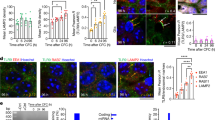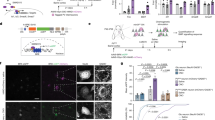Abstract
Excessive glucocorticoid exposure during chronic stress causes synapse loss and learning impairment. Under normal physiological conditions, glucocorticoid activity oscillates in synchrony with the circadian rhythm. Whether and how endogenous glucocorticoid oscillations modulate synaptic plasticity and learning is unknown. Here we show that circadian glucocorticoid peaks promote postsynaptic dendritic spine formation in the mouse cortex after motor skill learning, whereas troughs are required for stabilizing newly formed spines that are important for long-term memory retention. Conversely, chronic and excessive exposure to glucocorticoids eliminates learning-associated new spines and disrupts previously acquired memories. Furthermore, we show that glucocorticoids promote rapid spine formation through a non-transcriptional mechanism by means of the LIM kinase–cofilin pathway and increase spine elimination through transcriptional mechanisms involving mineralocorticoid receptor activation. Together, these findings indicate that tightly regulated circadian glucocorticoid oscillations are important for learning-dependent synaptic formation and maintenance. They also delineate a new signaling mechanism underlying these effects.
This is a preview of subscription content, access via your institution
Access options
Subscribe to this journal
Receive 12 print issues and online access
$209.00 per year
only $17.42 per issue
Buy this article
- Purchase on Springer Link
- Instant access to full article PDF
Prices may be subject to local taxes which are calculated during checkout






Similar content being viewed by others
Change history
06 May 2013
In the version of this article initially published online, the glucocorticoid receptor was identified at first mention as the type I corticosteroid receptor and the mineralocorticoid receptor as the type II; the reverse is true. The error has been corrected for the print, PDF and HTML versions of this article.
References
de Kloet, E.R., Vreugdenhil, E., Oitzl, M.S. & Jöels, M. Brain corticosteroid receptor balance in health and disease. Endocr. Rev. 19, 269–301 (1998).
McEwen, B.S. Protective and damaging effects of stress mediators. N. Engl. J. Med. 338, 171–179 (1998).
Lupien, S.J. et al. Cortisol levels during human aging predict hippocampal atrophy and memory deficits. Nat. Neurosci. 1, 69–73 (1998).
de Quervain, D.J.F., Roozendaal, B. & McGaugh, J.L. Stress and glucocorticoids impair retrieval of long-term spatial memory. Nature 394, 787–790 (1998).
Bangasser, D.A. & Shors, T.J. The hippocampus is necessary for enhancements and impairments of learning following stress. Nat. Neurosci. 10, 1401–1403 (2007).
Shors, T.J., Weiss, C. & Thompson, R.F. Stress-induced facilitation of classical conditioning. Science 257, 537–539 (1992).
Quirarte, G.L., Roozendaal, B. & McGaugh, J.L. Glucocorticoid enhancement of memory storage involves noradrenergic activation in the basolateral amygdala. Proc. Natl. Acad. Sci. USA 94, 14048–14053 (1997).
Bailey, C.H. & Kandel, E.R. Structural changes accompanying memory storage. Annu. Rev. Physiol. 55, 397–426 (1993).
Engert, F. & Bonhoeffer, T. Dendritic spine changes associated with hippocampal long-term synaptic plasticity. Nature 399, 66–70 (1999).
Yang, G., Pan, F. & Gan, W.B. Stably maintained dendritic spines are associated with lifelong memories. Nature 462, 920–924 (2009).
Xu, T.H. et al. Rapid formation and selective stabilization of synapses for enduring motor memories. Nature 462, 915–919 (2009).
Lai, C.S.W., Franke, T.F. & Gan, W.B. Opposite effects of fear conditioning and extinction on dendritic spine remodelling. Nature 483, 87–91 (2012).
Liston, C. & Gan, W.B. Glucocorticoids are critical regulators of dendritic spine development and plasticity in vivo. Proc. Natl. Acad. Sci. USA 108, 16074–16079 (2011).
Wellman, C.L. Dendritic reorganization in pyramidal neurons in medial prefrontal cortex after chronic corticosterone administration. J. Neurobiol. 49, 245–253 (2001).
Radley, J.J. et al. Repeated stress induces dendritic spine loss in the rat medial prefrontal cortex. Cereb. Cortex 16, 313–320 (2006).
Liston, C. et al. Stress-induced alterations in prefrontal cortical dendritic morphology predict selective impairments in perceptual attentional set-shifting. J. Neurosci. 26, 7870–7874 (2006).
Dias-Ferreira, E. et al. Chronic stress causes frontostriatal reorganization and affects decision-making. Science 325, 621–625 (2009).
Watanabe, Y., Gould, E. & McEwen, B.S. Stress induces atrophy of apical dendrites of hippocampal CA3 pyramidal neurons. Brain Res. 588, 341–345 (1992).
Morsink, M.C. et al. Acute activation of hippocampal glucocorticoid receptors results in different waves of gene expression throughout time. J. Neuroendocrinol. 18, 239–252 (2006).
Datson, N.A., van der Perk, J., De Kloet, E.R. & Vreugdenhil, E. Identification of corticosteroid-responsive genes in rat hippocampus using serial analysis of gene expression. Eur. J. Neurosci. 14, 675–689 (2001).
Stavreva, D.A. et al. Ultradian hormone stimulation induces glucocorticoid receptor-mediated pulses of gene transcription. Nat. Cell Biol. 11, 1093–1102 (2009).
Yuen, E.Y. et al. Acute stress enhances glutamatergic transmission in prefrontal cortex and facilitates working memory. Proc. Natl. Acad. Sci. USA 106, 14075–14079 (2009).
Karst, H. et al. Mineralocorticoid receptors are indispensable for nongenomic modulation of hippocampal glutamate transmission by corticosterone. Proc. Natl. Acad. Sci. USA 102, 19204–19207 (2005).
Lösel, R. & Wehling, M. Nongenomic actions of steroid hormones. Nat. Rev. Mol. Cell Biol. 4, 46–56 (2003).
Popoli, M., Yan, Z., McEwen, B.S. & Sanacora, G. The stressed synapse: the impact of stress and glucocorticoids on glutamate transmission. Nat. Rev. Neurosci. 13, 22–37 (2011).
Di, S., Malcher-Lopes, R., Halmos, K.C. & Tasker, J.G. Nongenomic glucocorticoid inhibition via endocannabinoid release in the hypothalamus: a fast feedback mechanism. J. Neurosci. 23, 4850–4857 (2003).
Hill, M.N. et al. Recruitment of prefrontal cortical endocannabinoid signaling by glucocorticoids contributes to termination of the stress response. J. Neurosci. 31, 10506–10515 (2011).
Hübener, M. & Bonhoeffer, T. Searching for engrams. Neuron 67, 363–371 (2010).
Roozendaal, B., Okuda, S., Van der Zee, E.A. & McGaugh, J.L. Glucocorticoid enhancement of memory requires arousal-induced noradrenergic activation in the basolateral amygdala. Proc. Natl. Acad. Sci. USA 103, 6741–6746 (2006).
Lohmann, C. & Bonhoeffer, T. A role for local calcium signaling in rapid synaptic partner selection by dendritic filopodia. Neuron 59, 253–260 (2008).
Knott, G.W., Holtmaat, A., Wilbrecht, L., Welker, E. & Svoboda, K. Spine growth precedes synapse formation in the adult neocortex in vivo. Nat. Neurosci. 9, 1117–1124 (2006).
Reul, J.M.H.M. & de Kloet, E.R. Two receptor systems for corticosterone in rat brain: microdistribution and differential occupation. Endocrinology 117, 2505–2511 (1985).
Gu, J. et al. ADF/cofilin-mediated actin dynamics regulate AMPA receptor trafficking during synaptic plasticity. Nat. Neurosci. 13, 1208–1215 (2010).
Meng, Y. et al. Abnormal spine morphology and enhanced LTP in LIMK-1 knockout mice. Neuron 35, 121–133 (2002).
Bellugi, U., Lichtenberger, L., Mills, D., Galaburda, A. & Korenberg, J.R. Bridging cognition, the brain and molecular genetics: evidence from Williams syndrome. Trends Neurosci. 22, 197–207 (1999).
Holsboer, F. The corticosteroid receptor hypothesis of depression. Neuropsychopharmacology 23, 477–501 (2000).
Miller, N.L., Tvaryanas, A.P. & Shattuck, L.G. Accommodating adolescent sleep-wake patterns: the effects of shifting the timing of sleep on training effectiveness. Sleep 35, 1123–1136 (2012).
Atkinson, G. & Reilly, T. Circadian variation in sports performance. Sports Med. 21, 292–312 (1996).
Ruby, N.F. et al. Hippocampal-dependent learning requires a functional circadian system. Proc. Natl. Acad. Sci. USA 105, 15593–15598 (2008).
Wright, K.P., Hull, J.T., Hughes, R.J., Ronda, J.M. & Czeisler, C.A. Sleep and wakefulness out of phase with internal biological time impairs learning in humans. J. Cogn. Neurosci. 18, 508–521 (2006).
Chaudhury, D. & Colwell, C.S. Circadian modulation of learning and memory in fear-conditioned mice. Behav. Brain Res. 133, 95–108 (2002).
Dailey, M.E. & Smith, S.J. The dynamics of dendritic structure in developing hippocampal slices. J. Neurosci. 16, 2983–2994 (1996).
Buffelli, M. et al. Genetic evidence that relative synaptic efficacy biases the outcome of synaptic competition. Nature 424, 430–434 (2003).
Colman, H., Nabekura, J. & Lichtman, J.W. Alterations in synaptic strength preceding axon withdrawal. Science 275, 356–361 (1997).
Tsankova, N.M. et al. Sustained hippocampal chromatin regulation in a mouse model of depression and antidepressant action. Nat. Neurosci. 9, 519–525 (2006).
Renthal, W. et al. Histone deacetylase 5 epigenetically controls behavioral adaptations to chronic emotional stimuli. Neuron 56, 517–529 (2007).
Guan, J.S. et al. HDAC2 negatively regulates memory formation and synaptic plasticity. Nature 459, 55–60 (2009).
Flavell, S.W. & Greenberg, M.E. Signaling mechanisms linking neuronal activity to gene expression and plasticity of the nervous system. Annu. Rev. Neurosci. 31, 563–590 (2008).
Flavell, S.W. et al. Activity-dependent regulation of MEF2 transcription factors suppresses excitatory synapse number. Science 311, 1008–1012 (2006).
McNally, J.G., Muller, W.G., Walker, D., Wolford, R. & Hager, G.L. The glucocorticoid receptor: rapid exchange with regulatory sites in living cells. Science 287, 1262–1265 (2000).
Feng, G. et al. Imaging neuronal subsets in transgenic mice expressing multiple spectral variants of GFP. Neuron 28, 41–51 (2000).
Yang, G., Pan, F., Parkhurst, C.N., Grutzendler, J. & Gan, W.B. Thinned-skull cranial window technique for long-term imaging of the cortex in live mice. Nat. Protoc. 5, 201–208 (2010).
Li, C.X. & Waters, R.S. Organization of the mouse motor cortex studied by retrograde tracing and intracortical microstimulation (ICMS) mapping. Can. J. Neurol. Sci. 18, 28–38 (1991).
Campolongo, P. et al. Endocannabinoids in the rat basolateral amygdala enhance memory consolidation and enable glucocorticoid modulation of memory. Proc. Natl. Acad. Sci. USA 106, 4888–4893 (2009).
Karssen, A.M., Meijer, O.C., Berry, A., Pinol, R.S. & de Kloet, E.R. Low doses of dexamethasone can produce a hypocorticosteroid state in the brain. Endocrinology 146, 5587–5595 (2005).
Binder, D.K., Papadopoulos, M.C., Haggie, P.M. & Verkman, A.S. In vivo measurement of brain extracellular space diffusion by cortical surface photobleaching. J. Neurosci. 24, 8049–8056 (2004).
Jeanneteau, F., Garabedian, M.J. & Chao, M.V. Activation of Trk neurotrophin receptors by glucocorticoids provides a neuroprotective effect. Proc. Natl. Acad. Sci. USA 105, 4862–4867 (2008).
Buitrago, M.M., Schulz, J.B., Dichgans, J. & Luft, A.R. Short and long-term motor skill learning in an accelerated rotarod training paradigm. Neurobiol. Learn. Mem. 81, 211–216 (2004).
Jeanneteau, F., Deinhardt, K., Miyoshi, G., Bennett, A.M. & Chao, M.V. The MAP kinase phosphatase MKP-1 regulates BDNF-induced axon branching. Nat. Neurosci. 13, 1373–1379 (2010).
Jiang, M. & Chen, G. High Ca2+-phosphate transfection efficiency in low-density neuronal cultures. Nat. Protoc. 1, 695–700 (2006).
Acknowledgements
We thank B.S. McEwen and Gan laboratory members for critical comments on this manuscript. This work was supported by grants from the US National Institutes of Health (R01 NS047325 and a subcontract of R01MH085324) to W.-B.G. C.L. is supported by grants from the US National Institute of Mental Health (K99 MH097822) and the DeWitt Wallace Reader's Digest Foundation at Weill Cornell Medical College. F.J. and M.V.C. are supported by grants from the US National Institutes of Health (MH086651 and NS21072).
Author information
Authors and Affiliations
Contributions
C.L. and W.-B.G. conceived the project and designed all experiments. C.L. collected, quantified and analyzed the in vivo spine remodeling data. J.M.C. and F.J. contributed to the design of the cortical culture experiments, and J.M.C. carried them out and analyzed the results. C.L. obtained cortical biopsies and plasma samples. F.J. and M.V.C. contributed to the biochemical analysis of the samples. Z.J. developed and shared the LIMK1 knockout mouse. C.L. and W.-B.G. wrote the manuscript.
Corresponding authors
Ethics declarations
Competing interests
The authors declare no competing financial interests.
Supplementary information
Supplementary Text and Figures
Supplementary Figures 1–9 and Supplementary Tables 1–6 (PDF 683 kb)
Rights and permissions
About this article
Cite this article
Liston, C., Cichon, J., Jeanneteau, F. et al. Circadian glucocorticoid oscillations promote learning-dependent synapse formation and maintenance. Nat Neurosci 16, 698–705 (2013). https://doi.org/10.1038/nn.3387
Received:
Accepted:
Published:
Issue Date:
DOI: https://doi.org/10.1038/nn.3387
This article is cited by
-
Interaction of hydrocortisone and illness severity on head growth in cohort of ELBW infants
Pediatric Research (2023)
-
The cortisol switch between vulnerability and resilience
Molecular Psychiatry (2023)
-
Loss of glucocorticoid receptor phosphorylation contributes to cognitive and neurocentric damages of the amyloid-β pathway
Acta Neuropathologica Communications (2022)
-
Stress vulnerability shapes disruption of motor cortical neuroplasticity
Translational Psychiatry (2022)
-
Glucocorticoid circadian rhythms in immune function
Seminars in Immunopathology (2022)



